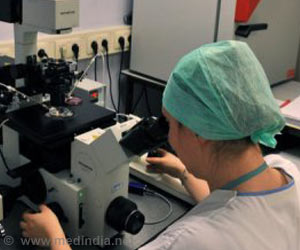
The common fruit fly Drosophila melanogaster looks like a sesame seed with wings, produces offspring by the thousands, and lives for around a month. These creatures don't resemble humans in any obvious way, but they share more than sixty percent of our genetic code. And scientists like UMD's Leslie Pick and Georgeta Crivat are finding that those similarities control basic biological processes that work alike in both species.
Drosophila melanogaster is easy to breed, raise and study in the laboratory, so it's widely used in research. Pick, chairman of the UMD Entomology Department, conducts experiments that use information about the fruit fly's relatively simple genome to illuminate biological processes in humans. Her recent research focuses on whether fruit flies use the hormone insulin the same way humans and other mammals do.
"We hope to use all the genetic tools we have available for flies, and the fact that we can breed them in huge numbers, very fast, to set up efficient screening tests for assessing new diabetes treatments," Pick said.
In a new study published Nov. 6 in the peer-reviewed online journal PLOS One, Pick and her co-authors found the basic mechanisms that humans use to regulate blood sugar – the process that goes awry in diabetes – are indeed shared with flies.
In humans, insulin controls the production and movement of glucose, the form of sugar that fuels mammalian cells. The movement of glucose into individual cells begins when insulin binds to a specialized insulin receptor on a cell. That causes a sugar transporter called GLUT4 to move from the cell interior to its membrane, allowing glucose to flow through the membrane, moving from the bloodstream into the cell. In diabetics, this process fails and sugar accumulates in the blood. In the main types of diabetes - Type 1, in which the body cannot produce insulin, and Type 2, in which the cells stop responding to insulin – high blood sugar levels can gravely damage many organs. The disease is one of the world's most serious health problems.
Advertisement
Source-Eurekalert















